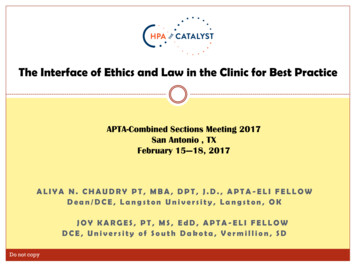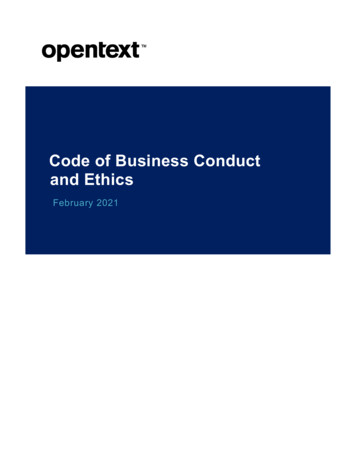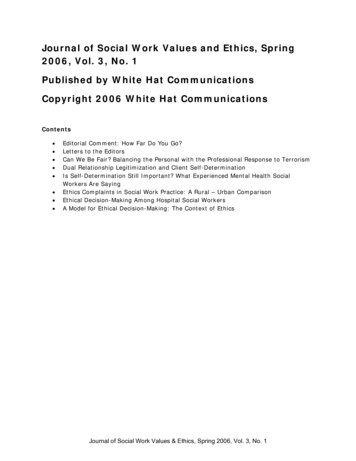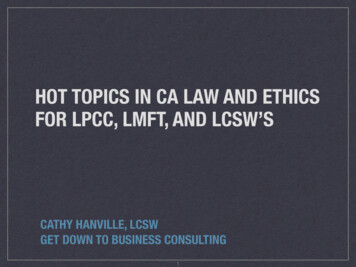
Transcription
The Interface of Ethics and Law in the Clinic for Best PracticeAPTA-Combined Sections Meeting 2017San Antonio , TXFebruary 15—18, 2017ALIYA N. CHAUDRY PT, MBA, DPT, J.D., APTA-ELI FELLOWDean/DCE, Langston University, Langston, OKJOY KARGES, PT, MS, EdD, APTA-ELI FELLOWDCE, University of South Dakota, Vermillion, SDDo not copy
Objectives Identify at least 4 core ethical principles valued in physicaltherapy clinical practice. Accurately explain the impact of legal obligations onethical physical therapy clinical decision making. Analyze professional clinical conduct for breach of at least2 legal/ethical duties.
Course Outline What is Ethics & what are the core ethical principles valued in clinicalpractice. Relationship between APTA ethical guidelines & values for PT & PTA Relationship between Ethics & Law—which is better or which is worse? Common ethical and/or legal concerns leading to professionalnegligence Risk Management strategies to prevent occurrence of professionalnegligence in the clinic
Startling Statistics
What is Ethics?WHAT ARE VALUES?ARE THEY CONNECTED?
Ethics Is Synonymous With: “rules of conduct” “moral code” “social values” “principles” “honesty”
Origins of “Ethics”https://www.google.com/search?q origin of word %22ethics%22&ie utf8&oe utf-8&aq t&rls org.mozilla:en-US:official&client firefox-a accessed 12-21-16
Ethics Defined Ethics derived from Greek word: Ethikos “moral duty” Includes: Biomedicalethics: “the science or study of moral values or principles,including ideals of autonomy, beneficence & justice” Professionalethics APTA ethical guidelines APTA values for PT & PTA
Biomedical Ethical Principles in Clinical Practice Principles: Autonomy Non maleficence Beneficence JusticeDistributive—societal Comparative—individual
Autonomy[3,4] Definition “Self governance”[3] Right to Independent decision making Patient/client actions are the result of patient’s/client’s own choices& decisions [4] regardless of patient’s/client’s ability to pay for services Examples patient’s/client’s right to select practitioner of choice right to refuse treatment AMA—Patient Bill of Rights3 Scott, R. Professional Ethics: A guide for Rehabilitation Professionals. Mosby: St. Louis, MO, 2009,Pg. 38-393 Munson, R. Intervention & Reflection: Basic Issues in Medical Ethics. 6th Edition,Wadsworth Thompson Learning; Stanford, CT. 2000
APTA Guide For Professional Conduct 2D statesthat “Physical therapists shall collaborate withpatients/clients to empower them in decisions abouttheir health care.”[3] Note: Principles of Confidentiality & InformedConsent extend from principle of Autonomy 4 APTA Code of Ethics. Available at APTA website located at:http://www.apta.org/uploadedFiles/APTAorg/About Us/Policies/Ethics/CodeofEthics.pdf accessed 12-23-16
Nonmaleficence “Above all do no harm” [3,4] --i.e. duty to do nointentional harm to patient/client. if you cannot help at least do no harm.applies to action & non-action [failure to act when action wasrequired]. Examples of violations intentional abandonment of patient/client. Sexual relations [consensual & nonconsensual] withpatient/client under care [COE 1.3].3 Scott, R. Professional Ethics: A guide for Rehabilitation Professionals. Mosby: St. Louis, MO,2009, Pg. 35-364 Munson, R. Intervention & Reflection: Basic Issues in Medical Ethics. 6th Edition,Wadsworth Thompson Learning; Stanford, CT. 2000
Beneficence [1,4] Duty to prevent harm: “fiduciary duty owed to patient”[1] Act in patient’s best interest [COE]—examples: lookingout for patient’s well being advocating for patient/client But not at the cost of harm to self—example: nomoral duty to save an individual from drowning ifone cannot swim moral duty to find help.3 Scott, R. Professional Ethics: A guide for Rehabilitation Professionals. Mosby: St. Louis,MO, 2009, Pg. 34-355 Kornblau, B., Starling, S. Ethics in Rehabilitation: A clinical Perspective. Slack: Thorofare,NJ; 2012; Pg. 13-15
Justice [3,4] Duty to provide fair treatment to all patients/clients. Two types—Distributive & Comparative Justice Distributive addresses issues of just distribution of health care at the macro orsocietal level—e.g. Universal health insurance protection for all individuals, Prevention & treatment of patients/clients with catastrophic diseasesas AIDS Health care rationing of services for terminally ill patients/clients3 Scott, R. Professional Ethics: A guide for Rehabilitation Professionals. Mosby: St. Louis, MO, 2009, Pg. 37-384 Munson, R. Intervention & Reflection: Basic Issues in Medical Ethics. 6th Edition, WadsworthThompson Learning; Stanford, CT. 2000
Comparative Justice addresses issues of just distribution ofhealth care at the micro or individual level E.g. denial of care to certain patients by HCP based on age, sex, race,disability, etc. Tuskegee Syphilis Study [1932-1972]—400 AA men with syphilisdenied life saving treatment with penicillin so that researchers couldstudy the effects of the disease [3]. EMTALA—Emergency Medical Treatment and Active Labor Act of1986 [federal antidumping law]. Prevents for profit hospitals from transferring indigent patients tocharity hospitals. Requires hospitals to conduct medical screening examinations onemergency patients & patients in active labor & stabilize emergencypatients prior to transfer regardless of the patient’s ability to pay [3].3 Scott, R. Professional Ethics: A guide for Rehabilitation Professionals. Mosby: St. Louis, MO, 2009, Pg. 3738
Professional ConsiderationsinDealing With Ethical Concerns
Significance of Professional Considerations [8] Articulate standards of ethical care Provide guidance re: what is fair, & expected Provide support to practitioner re: what is considered ethicalconduct by the profession Confirms practitioner’s & profession’s commitment toprovide ethical care Promote public trust as expectations are known &standardized
Professional Considerations Code of Ethics Guide for Professional Conduct Standards of Ethical Conduct for PTA Guide for Conduct of PTA Standards of Practice & Criteria
APTACode of Ethics&Guide For Professional Conduct
Code of Ethics First document of COE adopted in 1935 &addressed the following ethical violations: Making a diagnosisOffering a prognosisAdvertising for patientsCriticizing a physician or other HCPs [24] Old 2010 version was revised significantly[24] Swisher, L., Page, C. Professionalism in Physical Therapy. Elsevier Saunders, St. Louis,MO. 2005
COE outlines the APTA principles for ethicalphysical therapy practice formulated by HOD--highest policy making body of theAPTA.[26] Not legally binding
Current APTA-Ethical Principles & Standards “Principle/Standard 1 — Duty to all individuals Principle/Standard 2 — Duty to patients/clients Principle/Standard 3 — Accountability for sound judgments Principle/Standard 4 — Integrity in relationships Principle/Standard 5 — Fulfilling legal and professional obligations Principle/Standard 6 — Lifelong acquisition of knowledge, skills and abilities Principle/Standard 7 — Organizational behaviors and business practice Principle/Standard 8 — Meeting health needs of people” [27][26, 27. APTA official website: http://www.apta.org/Ethics/Core/ http://www.apta.org/uploadedFiles/APTAorg/About Us/Policies/HOD/Ethics/CodeofEthics.pdf andviewed on 07-22-13]
Guide For Professional Conduct GFPC is a tool to assist in the interpretation of the Codewith respect to: the appropriateness of professional conduct in specific situations &student professional developmentnot legally binding--”opinions, decisions, and advice of the Ethics &Judicial Committee” [receive authority through the APTA byelaws][27]. COE & GFPC include Directive & Non-Directive Provisions[27] Guide For professional Conduct. APTA official website. Located ice and Patient Care/Ethics/GuideforProfessionalConduct.pdf and viewed on 07-22-13.
STANDARDS OF ETHICAL CONDUCT FOR T A.ORG/UPLOADEDFILES/APTAORG/PRACTICEAND PATIENT CARE/ETHICS/GUIDEFORCONDUCTOFTHEPTA.PDFAND VIEWED ON 07-22-13.APTAStandards of Ethical Conduct forPTA&Guide For Conduct of the PTA[28]
Guide for Conduct of PTA serves to interpretthe Standards of Ethical Conduct for the PTA. Standards have all directive provisions! Majority are directive provisions in Guide!
Standards of Practice & Criteria[29][29] APTA OFFICIAL ABOUT US/POLICIES/PRACTICE/STANDARDSPRACTICE.PDF#SEARCH %22STANDARDS OF PRACTICE RG/ABOUT #SEARCH %22STANDARDS OF PRACTICE CRITERIA%22AND VIEWED ON 07-22-13
Standards of Practice & Criteria Professional standards developed by APTA House ofDelegates (HOD). Criteria developed by APTA Board of Directors (BOD) toelaborate on SOP. Provide direction re: various aspects of the professionincluding ethical considerations [Standard 1A]: “The physical therapist practices according to the Code of Ethics ofthe American Physical Therapy Association.The physical therapist assistant complies with the Standards ofEthical Conduct for the Physical Therapist Assistant of the AmericanPhysical Therapy Association”.
Not legally binding & so failure to follow SOPC: may not affect the individual’s license; but will affect the individual’s APTA membership However, if State Practice Act makes reference to SOP thenSOP may become legally enforceable APTA recommends viewing the Professional Standards as“essential for provision of high quality professional service tosociety, and provide a foundation for assessment of physicaltherapist practice.”[30][30]. APTA Standards of Practice. APTA official website located at: http://www.apta.org/uploadedFiles/APTAorg/About Us/Policies/Practice/StandardsPractice.pdf#search %22standards of practice criteria%22 and viewed on 07-22-13
What are Values?
Values Values are important in their worth or usefulness toindividuals such as: idealsprinciplesattitudesactions; and Values guide individuals in their: spiritual;moral; andpractical decision-making6. Purtilo, R. Haddad, A. Doherty, R. Health Professional & Patient Interaction:8Ed. ElSevier: St. louis, MO. 2014; Page 6.
Three Types of Values Personal Values Professional Values Societal Values
Personal Values Values shape and orient our choices. How do we determine this? by examining our choices; and seeing if the choices we made are consistent to what we say wevalue
Personal Values Early values will often influences your later values i.e. as you mature, your values will also evolve with you. Personal values sometimes may conflict with eachother
Personal Values When patients seek physical therapy it is often theirpersonal values that drive them to do so Value: being well or getting well Physical therapists are therefore, expected tocultivate personal values that foster respect forthemselves, patients, and others
Professional Values As a member of the physical therapy profession, youare also expected to embrace the values that areconsistent with the profession and what theprofessional practice entails
Professional Values Professional values may overlap with personalvalues What are the APTA values? PT Core Values PTA Value-based behaviors
PT Core Values7 Developed in 2000 and approved by APTA-BOD in 2003. Purpose: define professionalism in PT by describing sevenprofessional behaviors that a PT graduate was expected todisplay. With revision of Code of Ethics (COE) in 2009, each of theseven core values was linked with its appropriate principlein COE. 7. Value Based Behaviors For Physical Therapist Assistant Bod P01-11‐02‐02 [Position]. Available atAPTA website located at:http://www.apta.org/uploadedFiles/APTAorg/About Us/Policies/Judicial Legal/ValueBasedBehaviorsPTA.pdf#search %22PTA%20core%20values%22 accessed 12-23-16
P.T. Core Values8APTA VersionAccountability2.Altruism3. Compassion & Caring4.Excellence5.Integrity6. Professional Duty7. Social Responsibility1.ANC Version1.2.3.4.5.6.7.S Social ResponsibilityP Professional DutyE ExcellenceC Compassion & CaringI IntegrityA AccountabilityL aLtruism8. BOD P05-04-02-03Professionalism in physical therapy: core values[Amended BOD 08-03-04-10] Available at APTA website located t cessed 12-23-16.
Vale Based Behaviors For The PTA7 Developed 2009 with input from: Professional in Physical Therapy: Core Values A Normative Model of PTA Education: Version 2007 PTA-CPI: Version 2009 Minimum Required Skills of PTA Graduates @ Entry Level Newly adopted Ethics documents Problem Solving Algorithms for PTA Applicable APTA positions and policies Purpose: outline the depth and breadth of the valuesand attributes of the PTA
PTA Value Based BehaviorsAPTA VersionAcronym Version 1. Altruism S Social Responsibility 2. Caring and Compassion P PT/PTA Collaboration 3. Continuing Competence E rEsponsibility 4. Duty C Caring and Compassion 5. Integrity 6. PT/PTA Collaboration 7. Responsibility 8. Social ResponsibilityContinuing Competence I Integrity A Altruism L Legal Duty
Societal Values You belong to many communities within thelarger society. Examples include: extended family,neighborhood,ethnic community,part of the country where you live,school you attend,religious affiliation,social or civic organizations Each subgroup has values that you may accept,reject, or question
Societal Values Societal influence has increased globally because oftechnology including for example: World Wide Web,Radio,TV, andability to travel extensively
Societal Values Some values seem to be held in common by most orall of humanity. The need to be accepted within the societal realm ofvalues influences the well-being of almost everyone
Relationship Between The 3 ValuesPERSONAL—PROFESSIONAL—SOCIETALWHY IS THIS IMPORTANT?
Fragmented Values-in-Conflict6
Cohesive Value System6
Everyone’s values change from time to time due to: unexpected opportunities/events/happenings tragedies in life new insights Changes in a person’s values may impact their ethicaldecision making Circumstances that force most people to changethough usually evolve slowly
Relationship betweenEthics & ValuesEACH PRINCIPLE IN THE CODE OF ETHICS ISMATCHED WITH CORRESPONDING COREVALES
Are theCOE/SOEC/Guidelines/Valuessufficient?
NO!WHY?
The COE/SOEC/Values is a good starting point However, need to also consider: good Moral Judgment deep Personal Commitment GOVERNING LAWSState Practice Act Supporting State Administrative Regulations in any given situation!
Sample State LawsOKLAHOMAS. DAKOTA
Sample State LawOKLAHOMA PHYSICAL THERAPY PRACTICEACTOKLAHOMA ADMINISTRATIVE CODE
Oklahoma Physical Therapy Practice Act Statute developed by Oklahoma State Legislature binding legal effect Section 887.13 (10) states that a PT/PTA license shall not beissued or renewed, or an issued license will be suspendedor revoked of a PT/PTA who is “guilty of any act inconflict with the ethics of the profession of physicaltherapy.” [31] .Ok.stat.tit.59 sec.887.1 et. seq. available at Oklahoma State Board of Medical Licensure &Supervision’s Official Website:http://www.okmedicalboard.org/physical therapists/download/288/PTLAW.pdf & viewed on07-22-13]
Empowers the State Board of Medical Licensure &Supervision to: promulgate certain rules & regulations for the purpose ofcarrying out the Board’s duties under the Practice Act. suspend, deny or revoke licenses for violation of the rules& regulations [32] .[32. Ok. Stat. Tit. 59 Section 887.5.2 and Section 887.5.8 Oklahoma Physical Therapy Practice Act.Oklahoma Board of Medical licensure & Supervision website located at:http://www.okmedicalboard.org/physical therapists/download/288/PTLAW.pdfand viewed on 07-22-13]
Oklahoma Administrative Code
Rules & Regulations codified as Oklahoma Administrative Code. Outlines its purpose to facilitate administration of Practice Act [33]. Legally binding as referenced in Practice Act. Violations may lead to loss of license/other legal ramifications. Include “Standards of Ethics and Professional Conduct” adopted bythe Board.”—defined in Section 435:20-5-9[33-35. Ok. Admin. Code Tit. 435 Ch. 20 et seq available at Oklahoma State Board ofMedical Licensure & Supervision’s Official Website:http://www.okmedicalboard.org/physical therapists/download/456/PTRULES.pdfand viewed on 07-22-13]
Standards of Ethics & Professional Conduct [35]Outlines 12 ethical & professional principles: Respect rights & dignity Demonstrate Integrity & foster trust* Legal compliance Exercise sound professional judgment Improve professional competence Ethical research & physical therapy practice* Reasonable remuneration Confidentiality Advertise Services Refuse participation in/concealment of illegal & unethicalacts* Socially responsible Respect Peers & other HCP
Section 435:20-5-8 (b) (12)Specifically states that:the board can either deny license to orr e v o k e l i c e n s e o r t a k e o t h e r d i s c i p li na r ya c t i o n a g a i n s t a n i n d i v i d u al w h o v i o l a t e st h e . . “ S t a n d a r d s o f e t h i c s a n d p r o f e s s io n alconduct ” that was adopted by the board.
How Do We Resolve Ethical Concerns?IS IT ETHICAL?IS IT LEGAL?
Law-EthicsParadigms
4 Paradigms based on whether there is an ethicalobligation or legal obligation or both: Clinical practice violations of both law & ethics easy to detect No clinical practice violations of both law & ethics easy to detect Clinical practice violation of ethics but not law somewhat difficult: Legal but not Ethical Clinical practice violation of law but not ethics most difficult: Ethical action conflicting with the Law
L E Laws/Regs COE L-E Laws/Regs-COE E-L COE- Laws/Regs-L-E- Laws/Regs-COE
P.T. Example [5] FACTS: New PT with temporary license & previous reprimandsfor neglecting to lock patient w/c goes to treat a patient.Upon entering the room, finds patient on the floor Scenarios E L ? -E L ? E –L ? -E-L ?
E L immediately seeks help to assist patient E principle of beneficence [duty to help pt.] L standard of care of a reasonably prudent similarly trainedHCP in similar circumstances. – E – L does not seek assistance for fear of beingblamed for incident & improperly assists patientback to bed---dislocates patient’s shoulder & doesnot report incident. -E violation of principle of nonmalficence [do no harm] &veracity [duty to be truthful]-L violation of standard of care
– E L PT examines patient for injury—findingnone properly assists patient back to bed but doesnot report incident. L followed standard of care—no patient harm-E did not report--violation of principle of veracity & placedher needs over patient’s needs. E – L PT fails to examine patient for injury &improperly assists patient back to bed & reportsincident E followed principles of beneficence & veracity—recognized duty to assist & be truthful- L violated standard of care
Significance of ethical-legal distinction [] Differences in penalties: Unethical conduct penalty imposed by professionalassociation:loss of membership loss of certification reprimand--public or private public censure report made to license board publication of sentence
Illegal conduct penalty imposed by administrative agency
ALIYA N. CHAUDRY PT, MBA, DPT, J.D., APTA-ELI FELLOW Dean/DCE, Langston University, Langston, OK JOY KARGES, PT, MS, EdD, APTA-ELI FELLOW DCE, University of South Dakota, Vermillion, SD The Interface of Ethics and Law in the Clinic for Best Practice APTA-Combined Sections Meeting 2017 San Antonio , TX February 15—18, 2017 Do not copy











